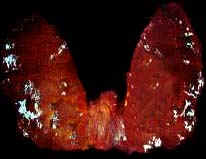The thyroid gland, shaped like a butterfly is located in the midline of the neck inferior and adjacent to our neck muscles, but anterior to the trachea or airway. 
Although the thyroid is one single gland it is anatomically divided into right and left lobes, with the middle of the gland between the two lobes referred to as the isthmus. Within the thyroid, there are four small independent glands that control calcium metabolism, known as the Parathyroid glands, due to their anatomical coexistence within the thyroid.
The principal function of the thyroid gland is the synthesis and secretion of thyroid hormones, which circulates in the body through the blood stream and exert their effects through interaction with specific cellular proteins known as thyroid hormone receptors. There are two principal thyroid hormones made and secreted by the thyroid, thyroxine (commonly known as T4) and triiodothyronine (T3). The majority of hormone secreted by the thyroid is T4, but the major active form of thyroid hormone is T3. T4 that circulates in the blood can be converted into T3 in many tissues by a specific enzyme known as a deiodinase, that removes one of the 4 iodine molecules from T4. A small population of specialized endocrine cells within the thyroid, designated thyroid C cells, produce the hormone calcitonin. The physiological importance of calcitonin remains unclear, but due to its effects on bone, calcitonin may be used as a drug for the treatment of osteoporosis. In a form of thyroid cancer due to malignant transformation of the thyroid C cells, known as medullary carcinoma of the thyroid, circulating levels of calcitonin may become elevated in the blood and hence calcitonin can be used in this disease as a tumor marker.
The major control of thyroid hormone synthesis and secretion resides at the level of the pituitary gland, a small endocrine gland that resides at the base of the brain. The pituitary gland, when functioning normally, is able to accurately sense whether the amount of circulating thyroid hormone is appropriate, and controls the thyroid gland via production and release of a pituitary hormone known as thyroid stimulating hormone (TSH). Diseases of the thyroid may be arbitrarily categorized into problems of thyroid hormone production (too much=Hyperthyroidism) or (not enough=Hypothyroidism) or thyroid growth or enlargement (diffuse symmetrical enlargement, single or multiple benign nodules or thyroid cancer). Some patients may have both a disturbance in thyroid function and may also have an enlarged thyroid with one or more thyroid nodules. When thyroid disease develops as a result of problems with the thyroid gland itself, it is referred to as Primary Thyroid Dysfunction (hypo or hyperthyroidism etc). Alternatively, if thyroid hormone levels are abnormal as a consequence of hypothalamic or pituitary problems, this is referred to as Secondary Thyroid Dysfunction (hypo or hyperthyroidism etc).
Examination of the thyroid can be carried out from the anterior or posterior position. The neck is flexed to relax the neck muscles, which can be gently displaced to examine each thyroid lobe. In many instances, deep palpation of the neck is necessary to feel the thyroid gland, which often elicits an uncomfortable choking sensation. Some authorities advocate self-examination of the thyroid using the "thyroid neck check". While in front of a mirror, focus on your neck and swallow some water. If a large bulge or asymmetric swelling becomes visible, see your physician for a more complete neck examination.
There are many misconceptions about the involvement of the thyroid in the causation of a large number of symptoms and health disorders. Patients and physicians are very aware that the symptoms of both hypothyroidism and hyperthyroidism are quite non-specific, and common in the general population frequently without biochemical confirmation of actual thyroid disease. This lack of correlation between symptoms and the presence of thyroid disease is often frustrating for all parties involved, leading some patients to question the validity and accuracy of thyroid hormone testing. A study of this issue examined the presence or absence of symptoms and biochemical parameters of thyroid dysfunction in Danish subjects. Not surprisingly, the correlation between specific symptoms, and biochemical and clinical evidence for thyroid dysfunction was poor. To review the data, see Validity of self-reported hyperthyroidism and hypothyroidism: comparison of self-reported questionnaire data with medical record review. Thyroid. 2001 Aug;11(8):769-73.
Patients are strongly encouraged to read widely about their thyroid disease so as to better understand their specific thyroid condition, and the various associated diagnostic and treatment regimens. Review carefully information on the Internet from sources that may or may not represent the opinions of authoritative highly trained and experienced health professionals. This Website is developed in part as a response to the proliferation of thyroid-related internet sites, many of which contain anecdotal non-validated information and content of questionable reliability. Wherever possible, this site provides links to representative references in the medical and scientific literature to allow patients to understand the scientific basis for medical decisions and recommendations. Review carefully information on the Internet from sources that may or may not represent the opinions of authoritative highly trained and experienced health professionals.
How is this site different?
This Website is developed in part as a response to the proliferation of thyroid-related internet sites, many of which contain anecdotal non-validated information and content of questionable reliability. Wherever possible, this site provides links to representative references in the medical and scientific literature to allow patients to understand the scientific basis for facts, medical decisions and recommendations. Patients are strongly encouraged to read widely about their thyroid disease so as to better understand their specific thyroid condition, and the various associated diagnostic and treatment regimens. Review carefully information o n the Internet from sources that may or may not represent the opinions of authoritative highly trained and experienced health professionals. Wherever possible, this site provides links to representative original references in the medical and scientific literature to allow patients to understand the scientific basis for medical decisions and recommendations.
